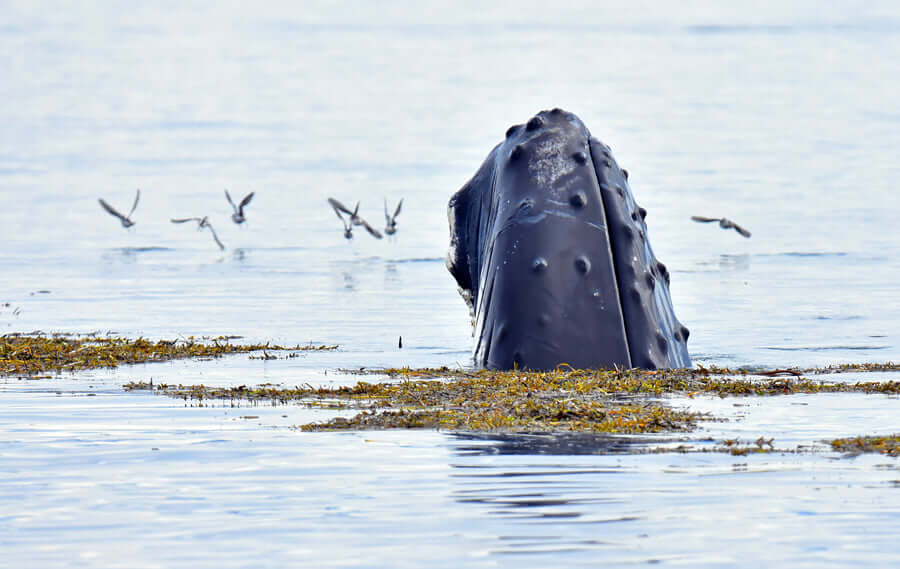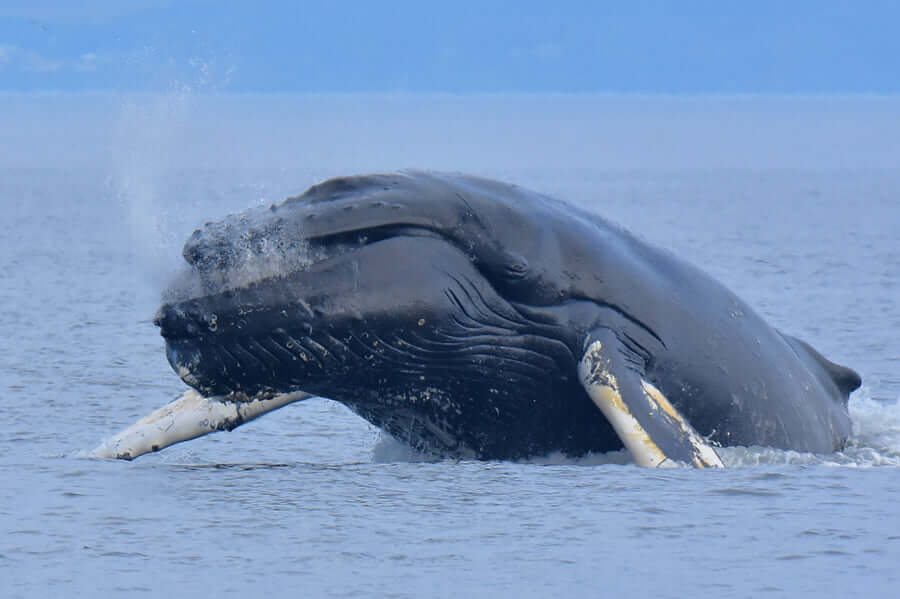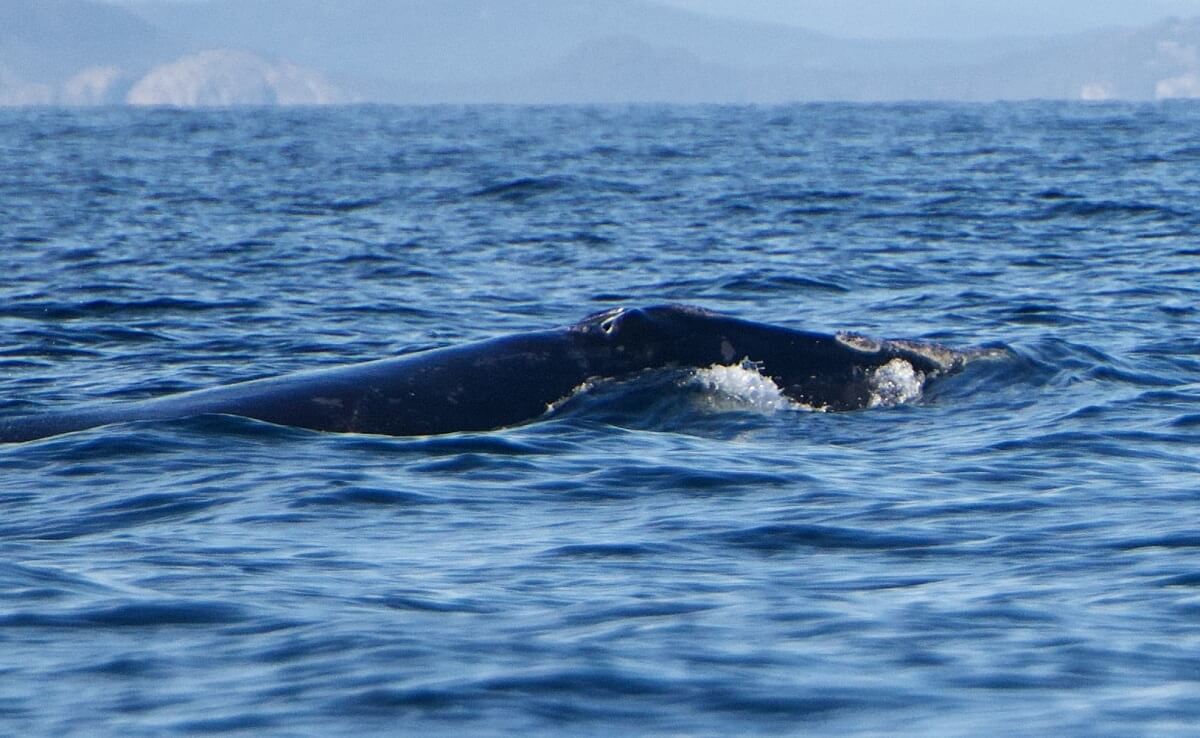In this final week of September, marine mammal sightings are slowly petering out with the end of the tourist season. But that doesn’t mean the whales are all gone! On the contrary, they will remain in the St. Lawrence for a while before they leave for their winter grounds… but for how much longer? That is the burning question for many of our readers and visitors. Let’s take a look at what’s been happening!
Beluga movements
Belugas are still being seen in the Saguenay Fjord and off the coast of Les Escoumins, as well as at the docks in Rivière-du-Loup, where mother-calf duos have been observed by staff of the Marine Mammal Observation Network (MMON). On the other hand, there’s been no trace of them for a week in Saint-Irénée, which suggests that these “canaries of the sea” are gradually undertaking their fall migration. With the onset of the cold, belugas will gradually move downstream toward the Gulf of St. Lawrence.
A feast of giants
From Tadoussac to Les Escoumins, including Les Bergeronnes and Essipit, these are still exciting times for whale aficionados. Minke, fin, and humpback whales have been offering an unforgettable spectacle to tourists venturing out on the Estuary, wowing them with majestic breaches and graceful pectoral fin salutes.
This genuine aquatic dance is a delight not only for cruise passengers but also for hikers near the shoreline. At the dunes of Tadoussac, for example, fin whales and humpbacks can be observed from the mainland. “I saw some almost every day!” exclaims an avid birder. Some of the visitors to the Marine Mammal Interpretation Centre are surprised by the significant numbers of large rorquals in the region. Shouldn’t the whales have already started migrating for the winter?
Not yet! The larger whale species will remain in the Estuary and the Gulf of St. Lawrence for a while yet before they undertake their marathon journey. When they hit the trail depends on the species. Humpbacks, for example, begin moving between late October and early November, though a few individuals may linger in the Gulf until December. Interestingly, males are usually the first to leave for the tepid southern waters. Females, which are larger than males, are believed to stay in their feeding grounds longer to refuel, as calving is extremely demanding!
In fin whales, departure dates are very similar to those of humpbacks. However, since 2010, it has become more and more frequent to observe them all winter long in the Gulf of St. Lawrence, and sometimes even in the Estuary! This phenomenon has also been observed in blue whales, which should normally have left the area by January. How do we explain these inconsistent observations? They may be linked to ice cover, which has been declining year after year. Researchers hypothesize that with less ice and shorter winters, the prey of these cetaceans enjoy better conditions over a prolonged period. Abundant prey over a longer period might be an incentive for the world’s two largest whales to spend more time in the area.
Action in the Gulf!
The Gaspé has also had its share of interesting sightings this week! Between Cap-Bon-Ami and Cap Gaspé, numerous humpback whales, white-sided dolphins, minke whales, and harbour porpoises are still plying the chilly waters of the Gulf. But strong waves up to two meters high have been limiting observation and photo opportunities on certain days.
At Cap-Bon-Ami, harbour seals and grey seals mingle, while at Pointe St-Pierre, harbour seals bask along the shoreline. One observer at Pointe St-Pierre is surprised to see a young seal sporting a funny-looking orange “cone” on its head. This “hat” has a number on it and the pup wearing it is part of a study that aims to monitor the survival rates and movements of young harbour seals.
Fewer observers, fewer observations
As the season progresses, harsher weather conditions and declining tourist traffic are limiting sightings in some areas. As we are well aware, a lack of sightings is not necessarily a reflection of an absence of whales, but rather a shortage of observers. After all, humans also “migrate” for the winter: few are daring enough to brave the frigid conditions that quietly envelop the North Shore to observe the sea.
A few minke whales are still frequenting the Godbout area and an occasional fin or humpback whale sometimes fires off a blast near Franquelin or Baie-Comeau. In the Mingan Archipelago, we have received reports of a few minke whales, fin rorquals, and harbour porpoises in the area, as well as the still impressive presence of bluefin tuna. But observations were very limited this week, much to the disappointment of local whale enthusiast Jacques Gélineau. “This has been one of our worst years for sightings!” he exclaims.
Right whale!
In the late afternoon of September 29, Jacques had a very nice encounter off the coast of Sept-Îles: a North Atlantic right whale! For this seasoned whalewatcher, this was his first sighting since 1998. Could it be the same individual detected by a hydrophone off Anticosti Island earlier that day? Indeed, thanks to the acoustic monitoring system deployed by Fisheries and Oceans Canada, even when there are no eyes on the water, we can be alerted to the presence of whales.
North Atlantic right whales, mainly frequent the Gulf of St. Lawrence from April through January and more rarely will venture into the Estuary. But on occasion an individual will stray farther afield than usual, sometimes even as far upriver as the Saguenay-St. Lawrence Marine Park!
Where are the whales this week? Observation map
These data were reported by our network of observers. The observations give a rough idea of the presence of whales, but do not in any way represent the true distribution of cetaceans in the St. Lawrence. Enjoy!
Click on the whale or seal icons to see the species, number of individuals observed, additional information or photos of the sighting. To zoom in on the map, click on the icon in the upper right corner. The map works well on Chrome and Firefox, but less so on Safari.
To display the list of observations, click on the icon in the upper left corner.









